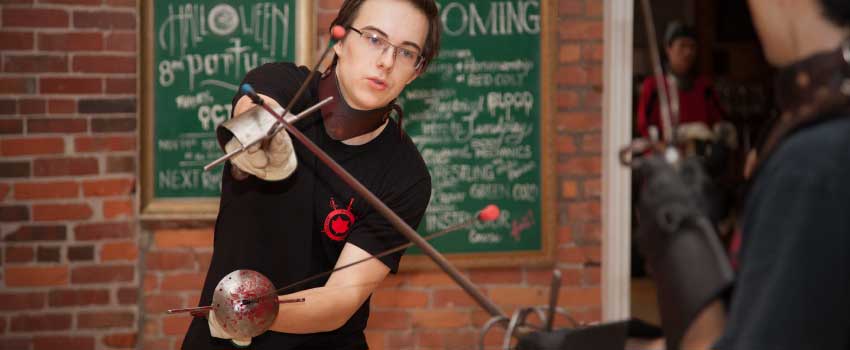While I was doing some research for another article I came across this video, on the Funker Tactical youtube channel, that includes some advice from a Vegas police officer about close quarters covering and entry.
There is a lot of merit to his approach and it shares a lot with to some traditional boxing forms within the Italian tradition we teach. The arms wrapped around the head have a strong resemblance to forms of Boar's Tooth used in some unarmed situations. Now, I don't agree with his comment that boxers and MMA fighters don't block. There are tons of blocking and counter striking through blocks. You don't have to do much searching to see this.
The reality is that sword fights are actually significantly faster than boxing matches due to the accelerative power of leverage on the sword and yet we still see a ton of blocking in swordplay. However, if all tactical options are open and you're not well trained, blocking is difficult. It's also much easier to block in a situation where you have a better understanding of the training of your opponents and the consistency of the environment they train for (like can be the case if your martial training focuses on one environment only, like much of HEMA that focuses on tournaments and duelling). Policing must necessarily take into account the chaotic nature of environments and the high variability of opponents. The strategies presented here to me on first blush have a lot of merits.
What I enjoyed most in this video was the highlighting of 3 particular principles he cited as paramount to good defence:
- Distance management
- Cover
- Angle
These happen to be the same principles that we look to in our approach to armed and unarmed fighting. In particular, I look to them not just as single avenues upon which you can create defence but as a triumvirate that you look to combine as much as possible.
Distance
Distance is a powerful defensive tool. Not only can it put you out of reach of an attack but distance is one of the best ways to buy yourself time. Forcing your opponent to cover a greater dis gives you time to develop counter-attacks, make effective covers, and seek opportunities to enter.
Through distance we seek to create opportunities to elongate our opponent's offensive movements and shorten our own defensive or counter-offensive movements (i.e., forcing our opponent to make a long range cut allows us the time to see it develop and counter-cut them with a shorter cut of our own timed at the end of their movement).
Cover
If you misjudge distance or angle it's essential to have your weapon in between your vital parts and the opponent's weapon. By understanding how to properly place and structure covers, we protect ourselves while creating barriers that the opponent must get around, which can buy us more time to make shorter counter-movements.
In our system, the term "cover" includes both parries (aka blocks) as well as placing our weapon in positions that constrain the opponent's ability to attack (which we call "stringere").
Angle
Changing your angle in relation to a given attack or in relation to the opponent is a powerful, principle to enact, though it may be a bit difficult. In the video, he uses angles to change both his tactical relationship (restricting what attacks the opponent can make) and his structural relationship (putting the opponent into a position that is mechanically difficult to work from).
Angle in swordplay is used in these same ways. In relation to an opponent: You might step to their side, right or left, as you make an attack in order to tactically restrict how they can respond to you (they can only attack you easily on one side / they must turn in a given way to face your blow), and to mechanically strike off of an opponent's centre so they are more easily put off balance or their defense defeated. Or, in relation to an attack: you may turn your centre into an attack in order to defeat it mechanically to parry or to strike through it, or you might step under a blow in order to avoid it while closing distance and changing the angle to the opponent.
These principles are fairly self-evident and show up in most martial arts that I have practiced. I enjoy seeing them called out explicitly and put to use in similar ways both to how we use them unarmed but in clear parallels to how they are employed in swordplay as well.
